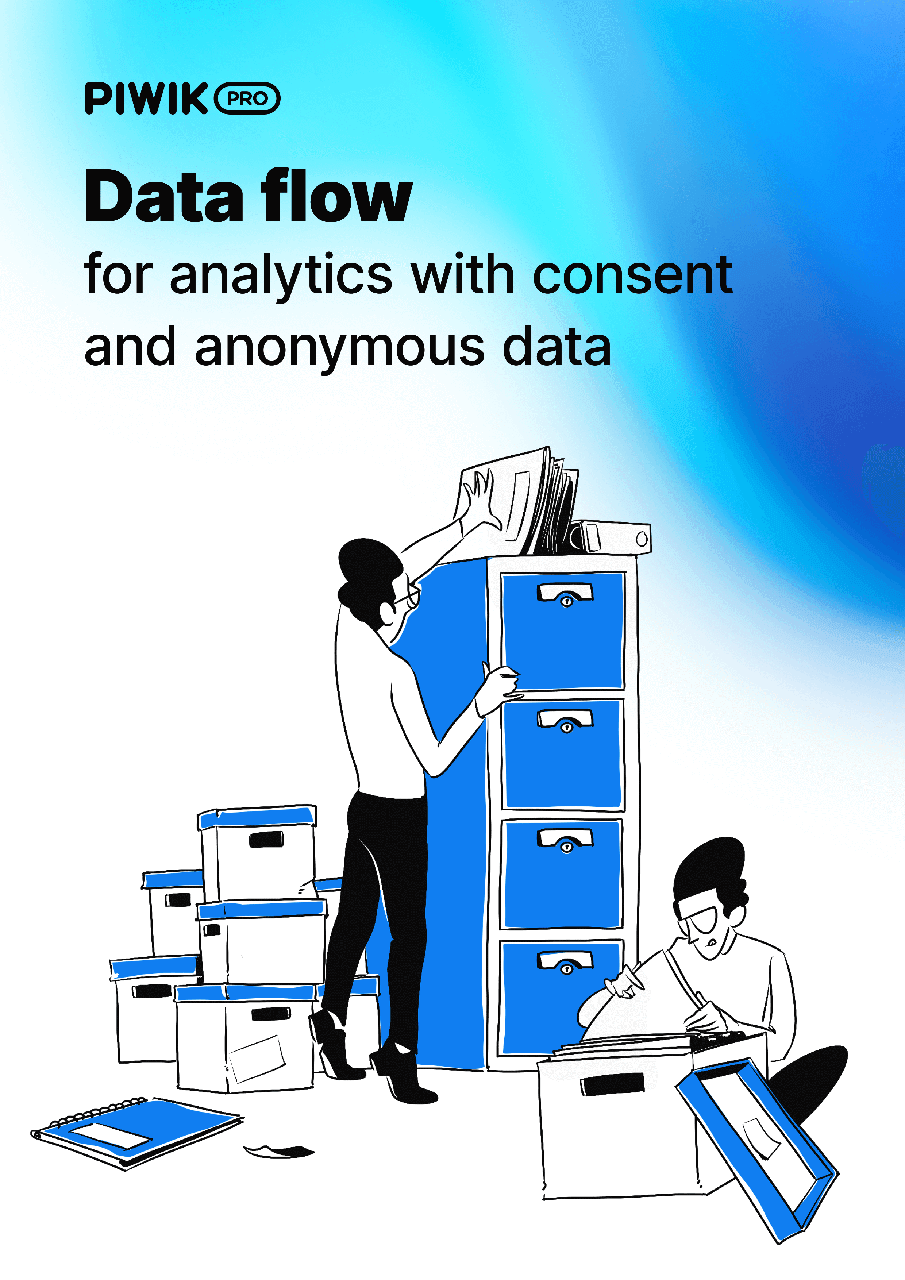Whether new to analytics or already well-versed, you might have heard a lot about collecting, managing and analyzing data. But what exactly happens in between? How does your data flow from one part of the analytics ecosystem to another?
Data can stream in different directions and back and forth between systems. It may take a lot of work to figure out how data moves around, how it’s transformed at every stage, and what ways your company can benefit from these processes. If you collect personal information, things become even trickier because you need to ensure privacy and security levels at all times.
In today’s post, we’ll walk you through the ins and outs of a data flow based on an example in Piwik PRO. You’ll see that even with consent collection and management, there are simple ways to design and describe data flow.
pro tip
We’re presenting the most popular setups of analytics platforms. There are many ways you can configure Piwik PRO to adhere to local data protection guidelines. For more details, review our help center article on how you can collect data in a privacy-friendly way.
A basic data flow
In most cases, the first step in a data flow is asking the visitor for consent to collect their data. If they grant consent, you gather their personal information and use it in your analysis. However, if the user declines consent or ignores the consent banner, at most, you will be able to collect and use anonymous data.
After this is settled, you should proceed with analyzing the data. For that purpose, you use the web or app data and import data from other sources, such as a CRM or marketing automation platform. You can also export data to other tools or platforms for further analysis or visualization.
Data flow step-by-step
Data analytics flow depends on consent, which sets the direction of the whole process.
Let’s look into a scenario in healthcare. Imagine a user visits your website, mygoodhealth.com. After they enter the site, they are served with a consent form.
Use a system like Piwik PRO Consent Manager to facilitate the process of collecting consents from users. It will save user decisions and send the information about them to the rest of the analytics platform.
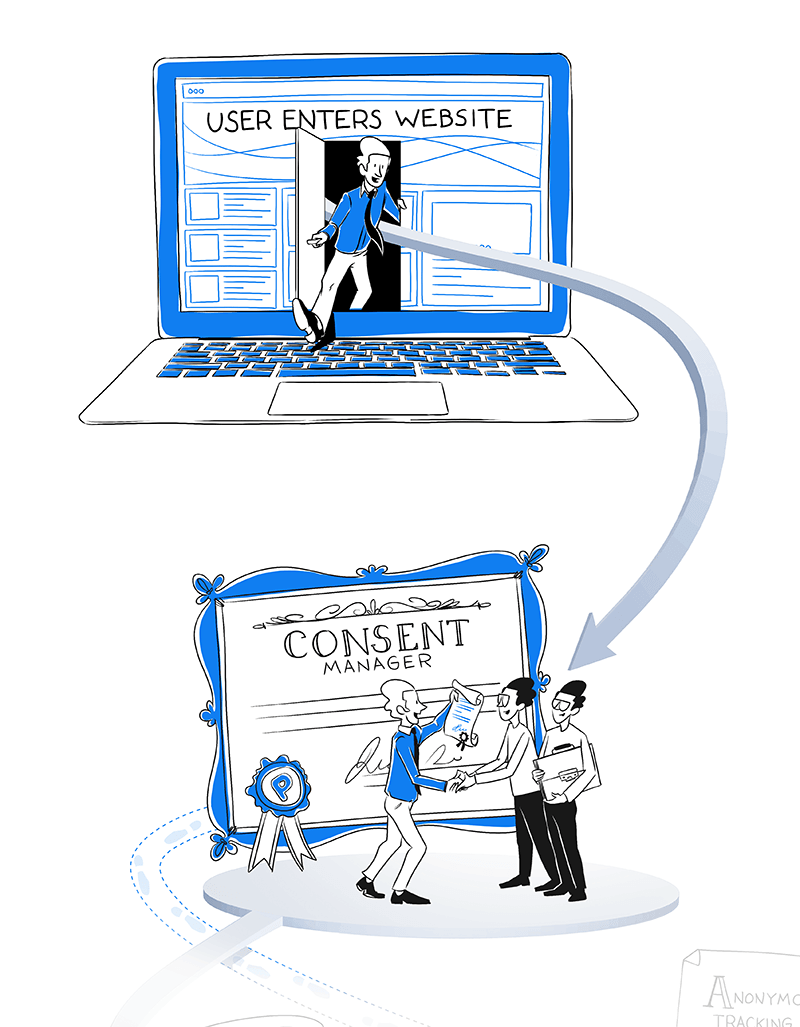
Users decide if they agree, don’t agree, or partially agree to the processing of their data, or they ignore the consent prompt and browse the website without making a decision.
Now is a good time to introduce two more modules of Piwik PRO Analytics Suite and explain their role in the data collection process:
- Analytics – Gathers both personal and anonymous data depending on the received consent. You can set the parameters for the tracker so it collects data in a way that matches your privacy and security requirements.
- Tag Manager – Manages tags – all those little pieces of code that fire based on conditions you define, often sending data to Analytics. If a user consents, tags are fired. Without consent, you still collect anonymous data with the Analytics module but without tags.
Tags won’t fire without user consent – this constitutes a so-called zero-cookie load. As a result, no user can be tracked by default. This setup allows for compliance with strict regulations, such as GDPR and local European guidelines, like those outlined by the French CNIL.
New laws that impose similar restrictions appear all the time, like the California Consumer Privacy Act (CCPA) in the US and the Personal Information Protection and Electronic Documents Act (PIPEDA) in Canada.
Whether a visitor agrees or not, you still get valuable insights, but the process will look different. Let’s analyze the possible scenarios.
A user doesn’t consent or ignores the banner
When a user doesn’t consent or ignores the consent banner, you can activate anonymous data tracking and collect some data using the Analytics module.
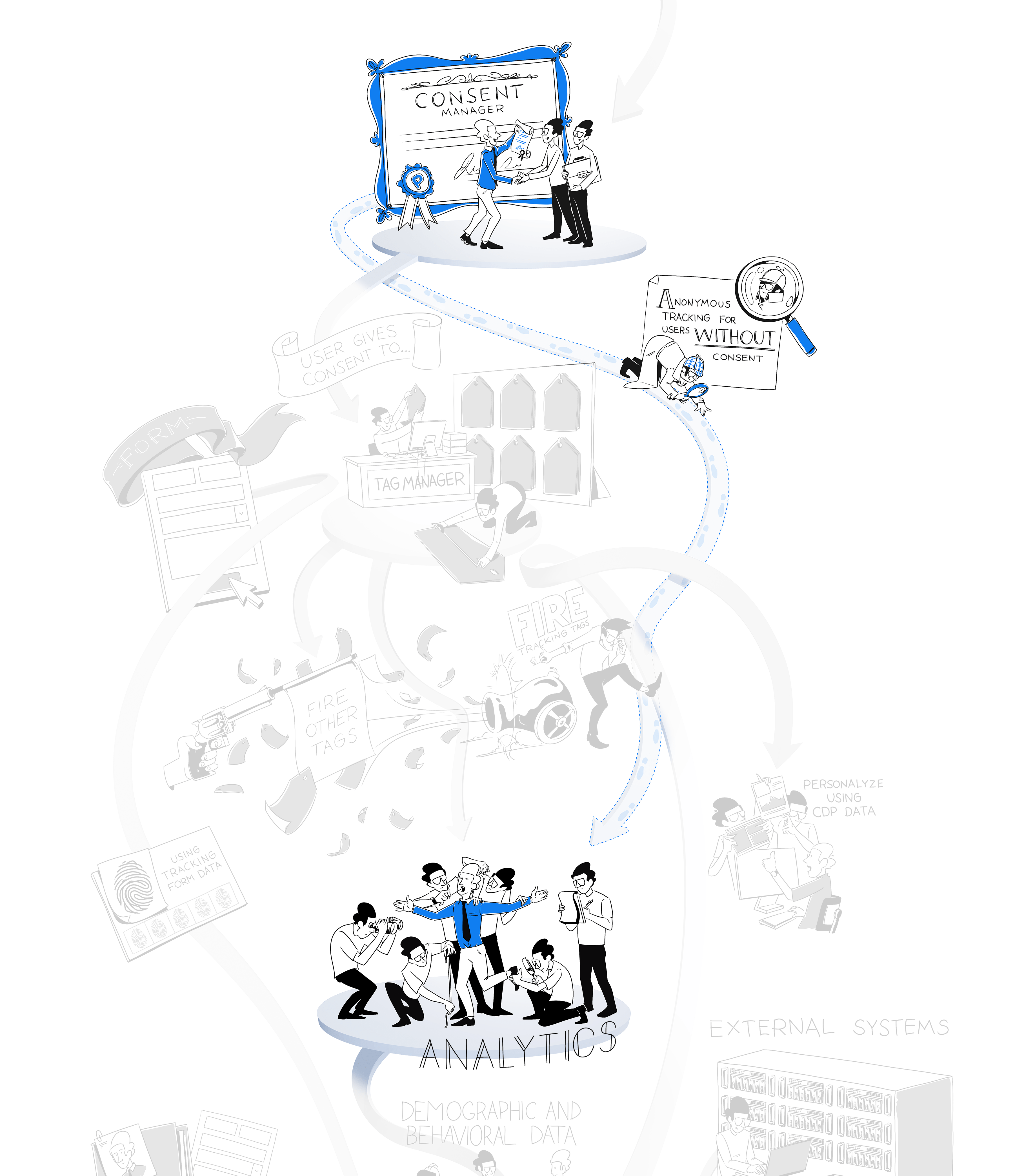
There are a few options available in Piwik PRO for when you don’t get user consent. They differ based on the technology used for data collection.
Here are the methods:
- Collect data using a 30-minute cookie: This method uses a first-party session cookie to collect data. After 30 minutes, the cookie is removed from the browser. The major advantage of this approach is that there are no duplicate sessions. This is also the most reliable anonymous data collection method.
- Collect data without cookies: This method uses a session fingerprint deployed on the device. The analytics platform won’t create or store any cookies in visitors’ browsers. The major advantage of this method is that it’s permissible under several regulations, such as the German TTDSG/TDDDG. The downside is that it creates duplicate sessions, which results in less accurate data. Both of the options mentioned so far let you capture all the traffic, as well as session and event metrics. The tracker collects the information and binds it into a session of a non-returning visitor. Visitor metrics will only be collected after a user consents. There is also a third option…
- Don’t collect data: The tracking code won’t be fired for visitors. If you disable tracking completely, there won’t be a trace of data about visitors that don’t consent to data collection. You won’t even see a page view for that user.
Naturally, anonymous tracking has limitations. It won’t let you collect and store personal data unless you have explicit consent. You also won’t be able to recognize new and returning visitors or identify visitors across sessions. Anonymous tracking will only work if browser fingerprinting is deactivated and geolocation is based on anonymized IP addresses or is deactivated.
If you’d like more details on what data you can collect anonymously, we recommend reading our post on anonymous tracking: how to do useful analytics without personal data.
A user gives consent
You have more opportunities if you receive explicit consent from users.
When a user gives their consent, you can use their information for different purposes depending on what they agree to. These include analytics, A/B testing and personalization, marketing automation and remarketing.
Once consent is registered, Tag Manager fires an analytics tracker. As the visitor interacts with your site, the Analytics module jumps into action by gathering basic information about the visitor’s:
- Device
- Operating system
- Browser name
- Browser language
- Country
It also gathers information about the content the visitor interacts with, such as:
- Pages viewed
- Videos played
- Forms filled
- Files downloaded
- Clicks on elements of the website or app
- Impressions of content
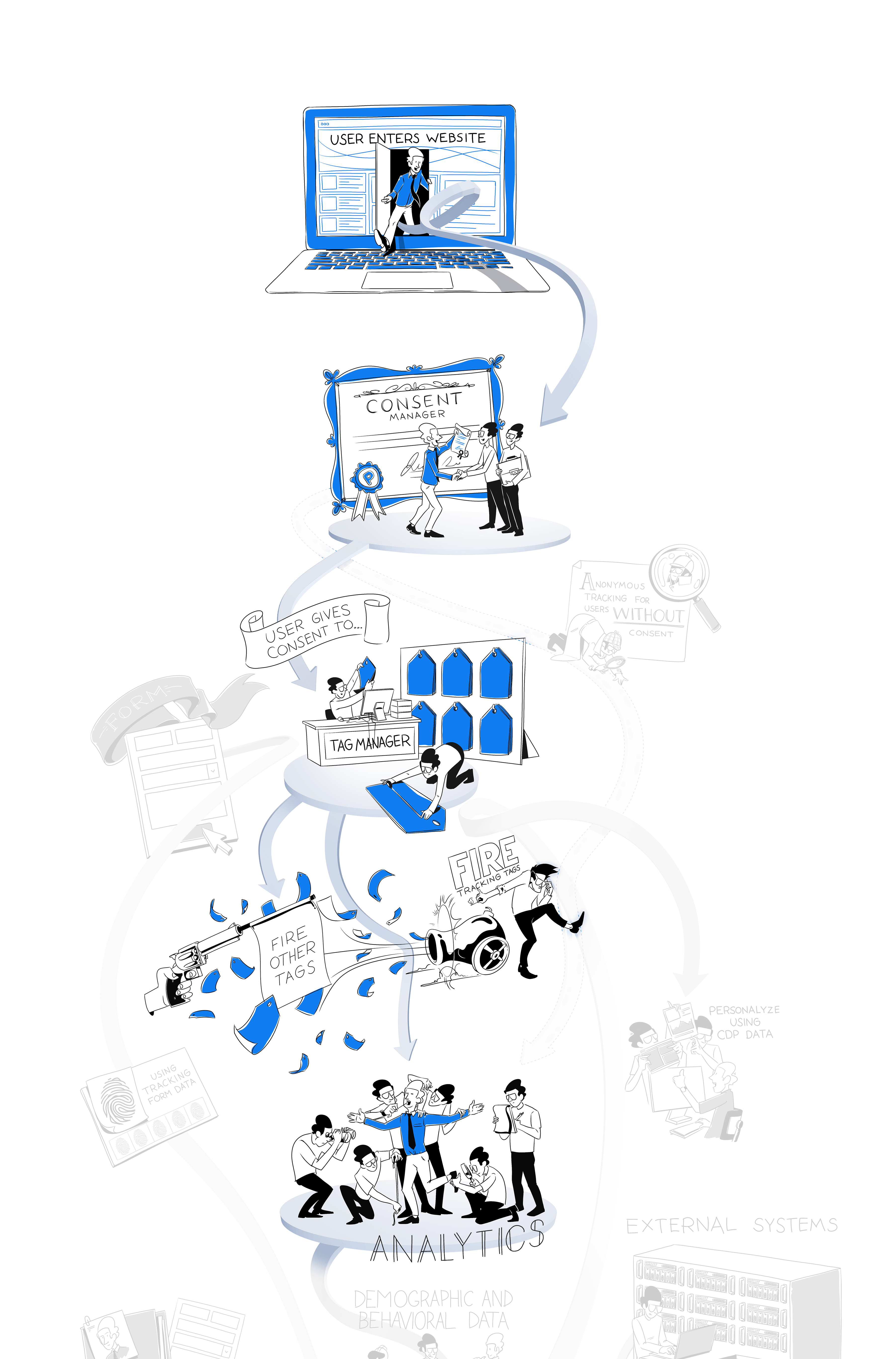
Making more out of data with a CDP
Collecting user data is not the end of the process.
Your web and app analytics data can be integrated along with data from other sources using Customer Data Platform (CDP), the final module of Piwik PRO Analytics Suite.
CDP helps you connect data scattered across different systems into complete customer profiles that map all user characteristics and behaviors.
Your visitor may browse through your site mygoodhealth.com, click on Information for patients, Our facilities, and finally, Specializations. From that page, they can navigate to Contact and fill out the form where they share their name, email address and phone number.
All this behavioral data – visited pages, completed events, clicks, scroll percentages, filled out forms – as well as other acquired information, such as demographics, order history, consent records, sales interactions, data from other sources, and more, will appear in the single customer views. You can enrich user profiles with custom attributes – such as personas that specific users represent or support tickets they’ve created – by integrating CDP with other tools using webhooks and automation tools.
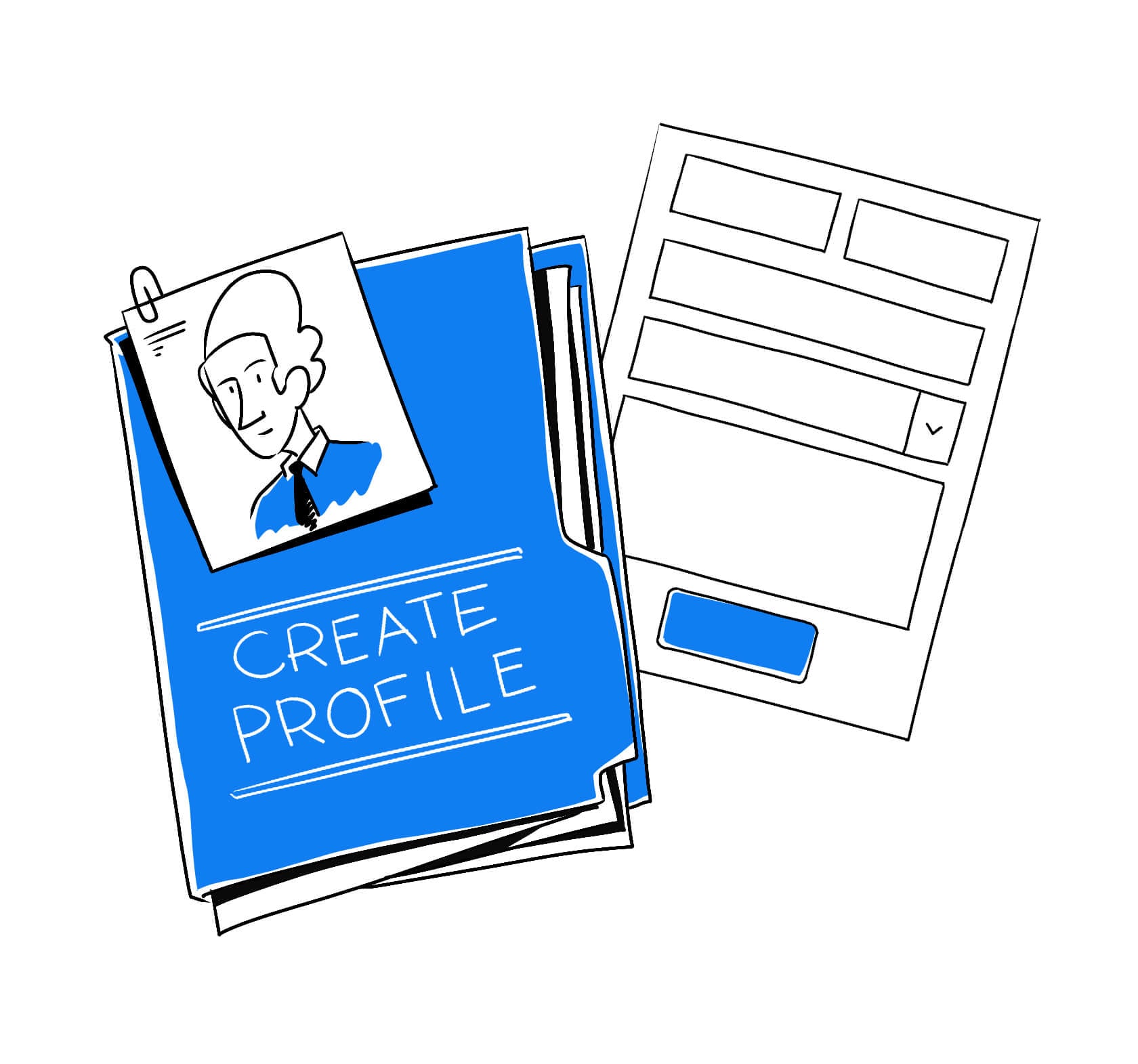
As the user returns to your website or app, performs more actions and lets you collect more data, their profiles will expand over time.
Combining all these sources helps you speed up specific processes as you fill in gaps in the customer journey. With more data at your fingertips, you can better adjust your products and services to the needs of your visitors.
An essential aspect of creating user profiles is deterministic identity resolution, which consists of comparing and matching first-party identifiers such as email addresses, login data, device ID, cookie ID, to recognize that pieces of information refer to the same customer.
To learn more about how customer profiles are built and ways to use them in a CDP, check out our blog post: Single customer view (SCV): what is it and how does it work?
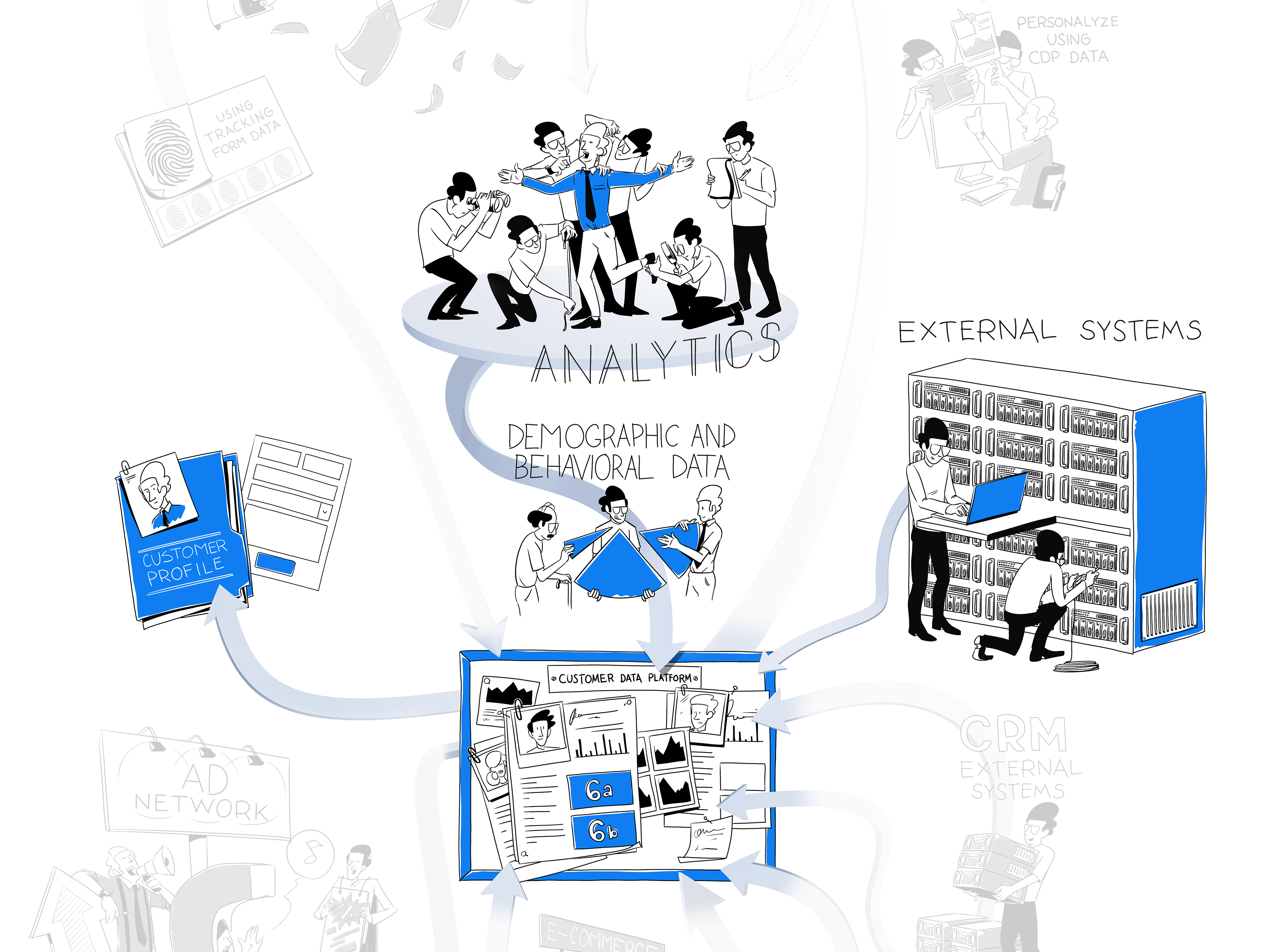
Unified customer profiles come with many new opportunities.
You can trigger personalized marketing campaigns based on customer activity and demographics.
Piwik PRO’s CDP allows you to segment audiences based on user attributes such as source, country, first visited URL or total revenue. Customer attributes are collected by the CDP automatically from analytics events and are matched with the given user’s profile through first-party identifiers.
You can also create audiences with behavioral conditions according to the frequency of events over time. For example, you can create an audience of people who visited a page “store” 3 times in the last 7 days.
If you plan and set up your audiences correctly, you end up with highly specific user segments that allow you to better target clients and visitors and help them convert.
Read our article on Audience targeting: how to successfully use a CDP to find out how you can segment users to improve the effectiveness of your audience targeting efforts.
Once your data is assembled into profiles and segmented, you can easily put it into action in other systems and platforms.
The Piwik PRO CDP lets you send selected attributes to numerous destinations through webhooks and automation tools, such as ad platforms, email marketing tools, CRM and others. Activation sends the customer profile attributes to the webhook’s endpoint. The webhook is triggered when the customer profile becomes a member of the audience.
Keep data protection regulations like the GDPR in mind. Privacy laws are updated frequently, so teams should stay on top to ensure they are gathering, processing, and storing data in a compliant way. Make sure the data you connect from other tools is collected with explicit consent where applicable.
Apart from using the available tools, you have the option to create custom activations and define more advanced integrations.
To get more detailed knowledge on the possibilities of data activation, read our blog post on What is data activation and how does it fit into your data analytics stack.
By combining Tag Manager, Analytics and Customer Data Platform, you create a core pipeline of data flow in which the modules complement one another.
We’ve shown you just a fraction of what you can achieve, but there are endless opportunities to track the right data, get it from selected sources and activate it in other places.
We’ll discuss some of those options in the following sections.
Get more data flowing through your stack
You already have some idea about how Tag Manager signals to Analytics what data to collect, then sends it for segmentation and activation in CDP. These modules work as a trio, collecting and exchanging information as users interact with your website.
Every time a returning visitor engages with your site or uses your app, their CDP profile will keep updating to become richer and more complete. But you should also expand the volume and improve the quality of the data you add to your system by connecting more sources to your CDP.
With Piwik PRO, you get the flexibility to set up your data flow in a way that protects the security of users’ personal data. You can integrate sensitive data and choose one of our safe hosting options. Piwik PRO also holds ISO-27001 and SOC 2 certifications.
You have complete control of your data as Piwik PRO doesn’t share it with any third parties, which is crucial in sectors such as healthcare, finance and government.
Learn more about our approach to data protection and HIPAA compliance here:
Let’s get back to our mygoodhealth.com example. It’s a medical website where people find and book appointments with specialists at different facilities, read articles explaining medical conditions and symptoms, and receive personalized health tips after providing some information about themselves.
Users can also pay for a premium service to get priority access to online and in-person consultations, on-demand medical advice through the phone, and unlimited access to articles and guides. Apart from the website, there is a mobile app where users easily log into their accounts and browse the platform’s features.
With Piwik PRO, you’ll get valuable data about how and when customers use the website and app. You see which of your offerings they are most interested in, what topics they read about most often, and what services they have already used.
You’ll be able to measure the average rating of appointments and video consultations. By looking at ratings of recent appointments correlated with other factors, you can identify possible reasons for churn and customer dissatisfaction. Tracking the last appointment date makes it easy to decide when to ask for feedback via a survey.
You can gather detailed information on the user experience on the site and in the mobile app, such as:
- Time spent on different parts of the service
- Clicks on links and buttons
- Most visited pages
- The adoption rate for new features
- The popularity of specific articles and videos
After analyzing this data, you can present specific recommendations to product designers.
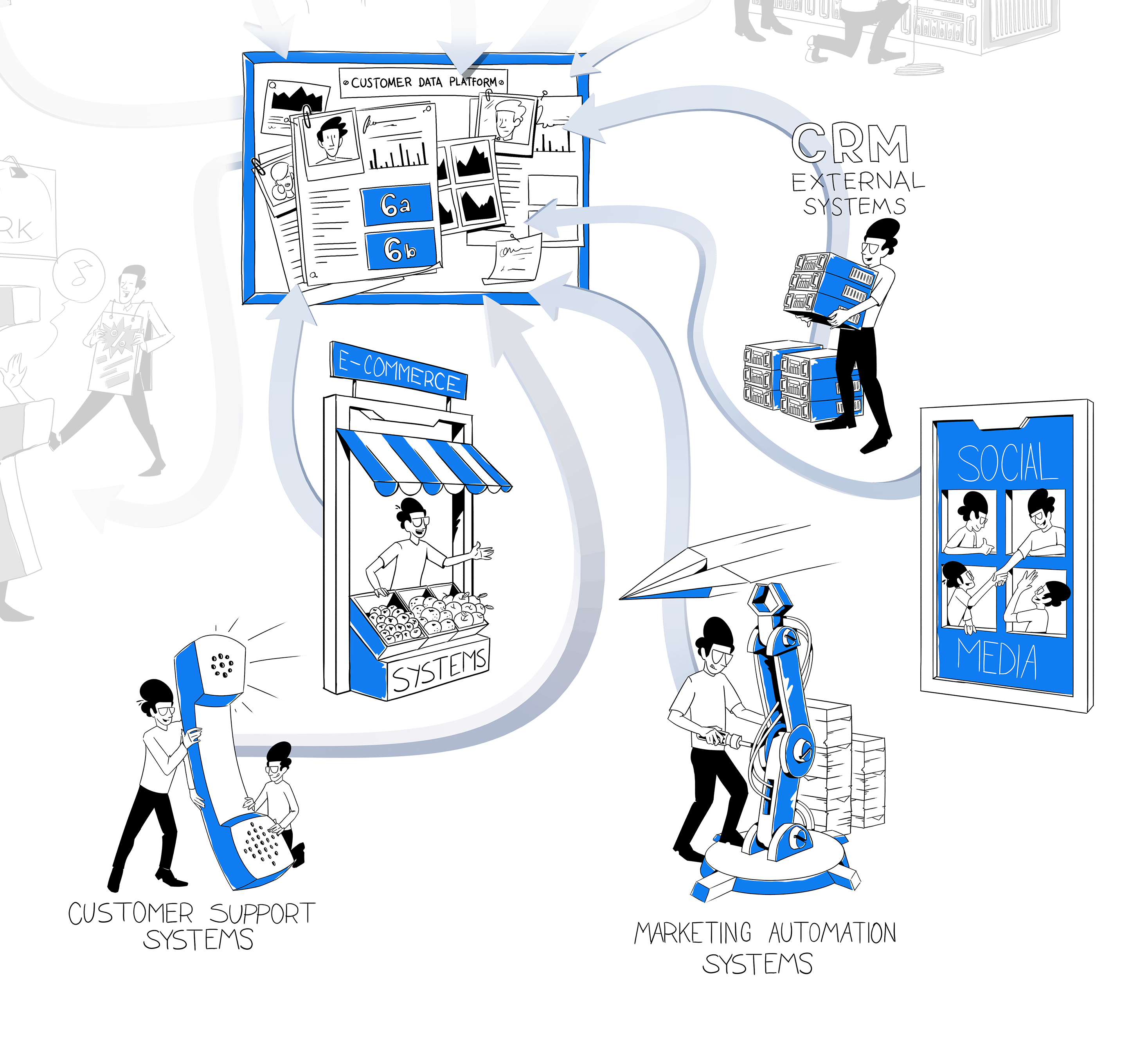
Having this penetrating insight means you’ll be able to connect information about users to how visitors behave on the service and how they renew and cancel memberships. Those connections help you infer what visitor activities lead to higher satisfaction and membership renewals.
Putting the data into action
Piwik PRO allows you to trigger actions based on the CDP audience segments we’ve already mentioned.
You can pick one of the created audiences and tailor your activities – for example, showing an ad, displaying personalized content, sending an email campaign – to your targeted segment. You can activate your audiences with a CDP by sending them to various tools and platforms. It’s up to you what exact user attributes you want to base your campaigns on.
In Piwik PRO, you can use countless integrations and transfer data to numerous destinations like Hubspot, Mailchimp, Slack, Zendesk, Twilio, LinkedIn, Facebook Ads, Google Ads, Zapier, and many more. You can also trigger tags for remarketing ads, A/B testing, on-site retargeting, personalization, and other tools in real-time.
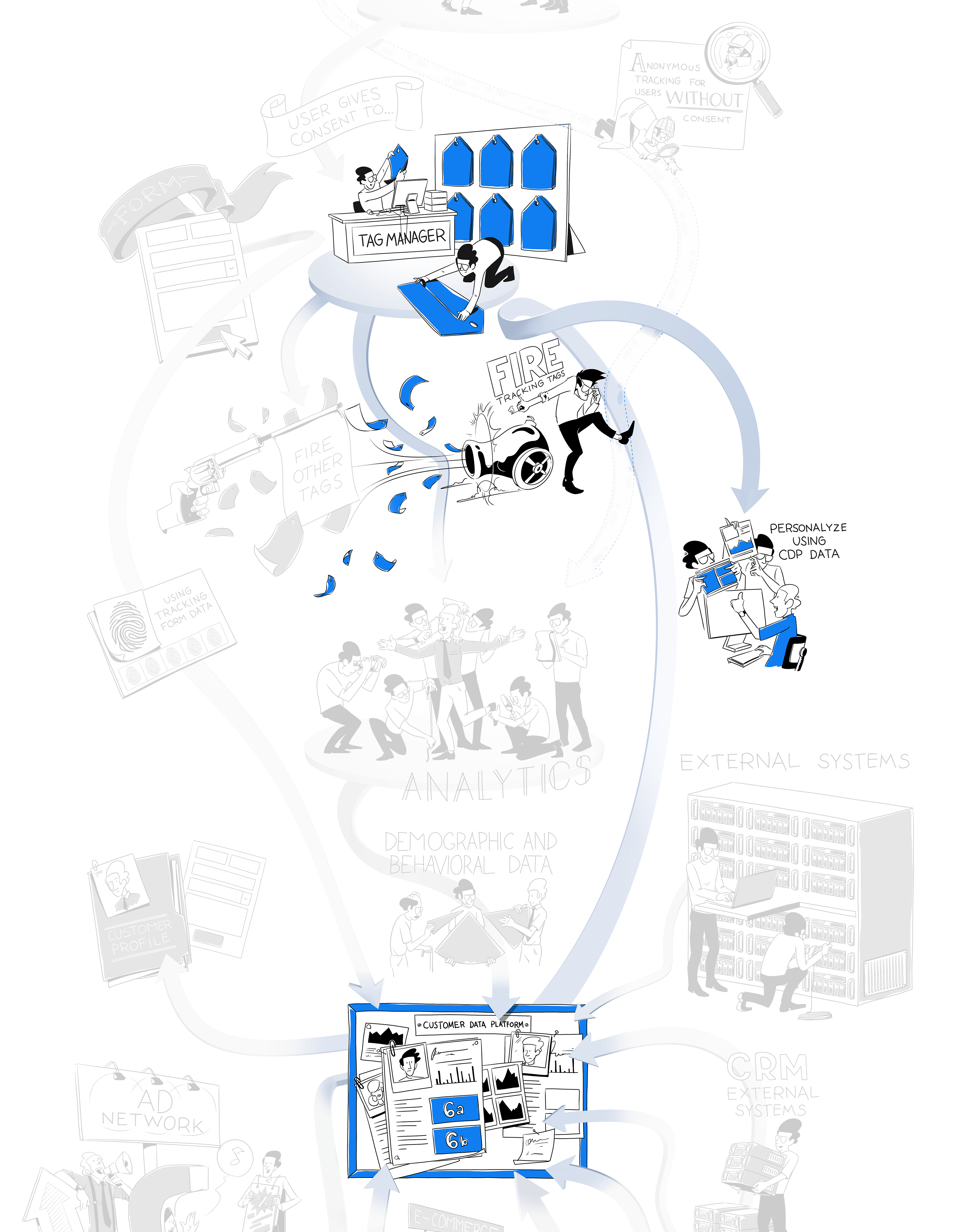
For example, you can segment existing customers who haven’t filled out a survey but have scheduled and completed an online or in-person consultation in the last 14 days. You can then email them a survey to get feedback on their consultation.
Or, you can create an audience of customers who have used your services before – for example, completed three consultations with the same specialist in the last 12 months. You can show them an ad banner with a complementary offer, such as a discount for another consultation.
Or, let’s take an audience of clients that paid for the premium service but haven’t visited your site or app or used your services in the past 6 months. You can serve them branding ads talking about the benefits of your platform and presenting its features.
Activating your audience on ad networks
You can also use the information you have to enhance your marketing outside the Piwik PRO ecosystem. One such option would be activating your CDP audience on Facebook Ads, Google Ads or other ad networks.
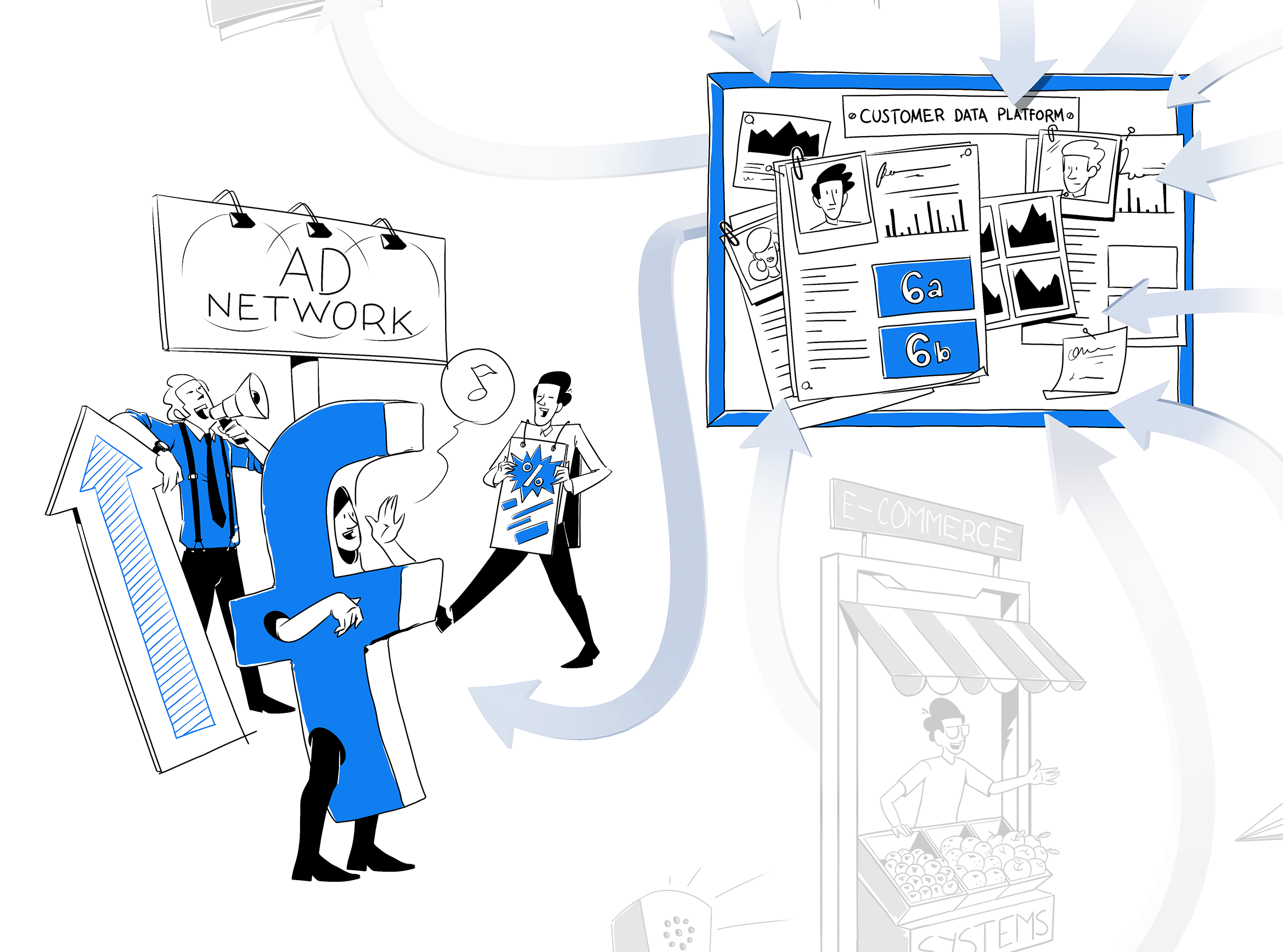
CDP recreates your audience in Google Ads or Facebook Ads but only using the data these two platforms already have. The data you have in Piwik PRO will not be exported or copied to these tools in any way during audience activation. The process is essentially an audience approximation in external ad networks.
You still benefit from targeting your CDP audiences and running personalization campaigns on external platforms while maintaining high data privacy and security standards.
The benefits of understanding how data flows
Analytics users often focus exclusively on deciding what data to gather, interpreting it, and making strategic decisions based on the results. These are all good things to think about, but you should still understand how your data pipes are connected to use the gathered data to the full extent of its capabilities.
Understanding data flows empowers you to make new connections with the help of complex platforms like Piwik PRO Analytics Suite. You can do so while ensuring the data stays safe and private throughout the process.
- 6 ways analytics software collects data online – plus a comparison of 5 popular platforms
- How Analytics & Customer Data Platform Can Help You Track the Full Customer Journey
- What is privacy-friendly analytics?
If you have any questions about the data analytics process or the features of Piwik PRO’s modules, reach out to us! Our team will be happy to address any questions.











